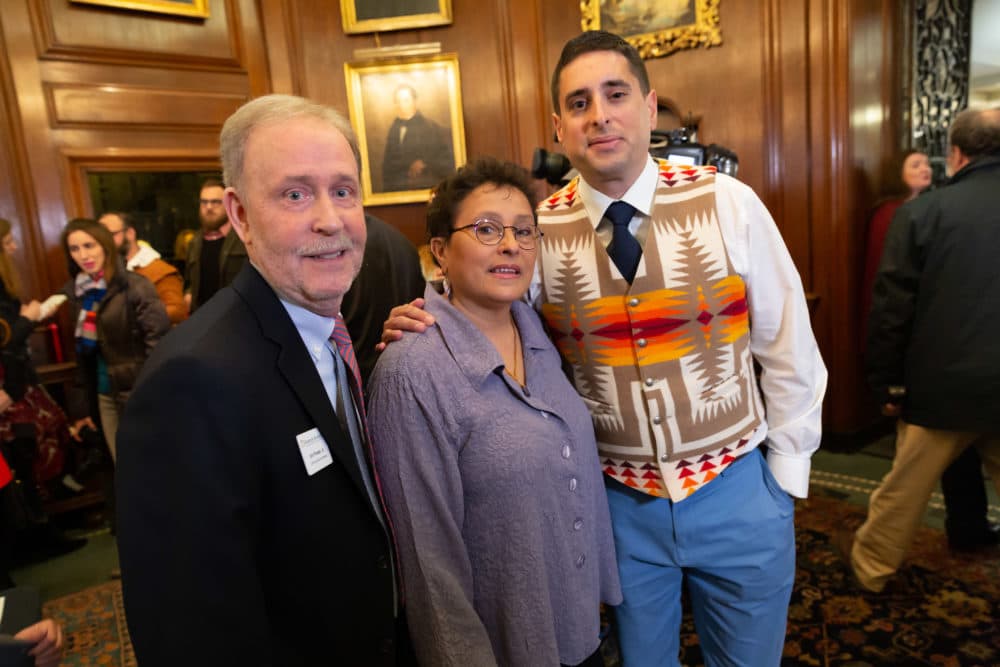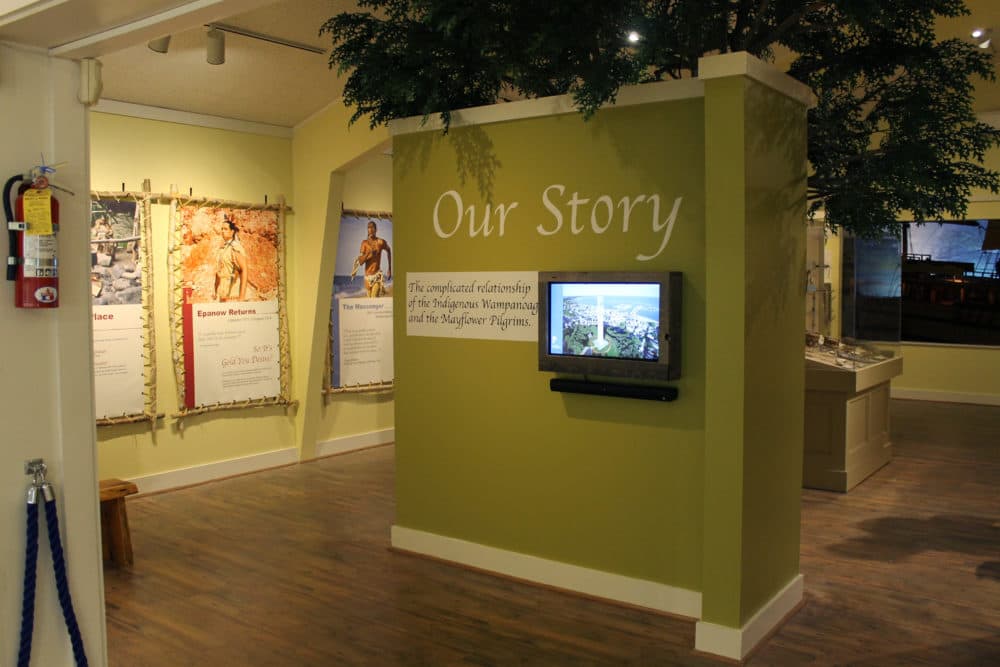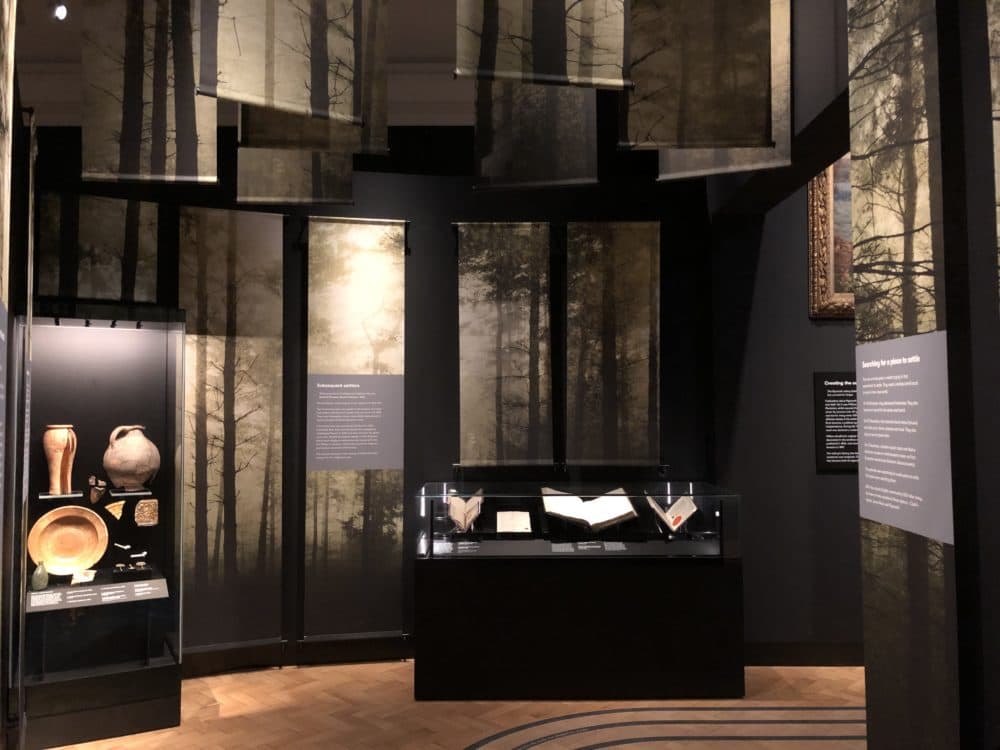Advertisement
A Mother-And-Son Duo Are Re-Examining History To Illuminate Wampanoag Stories

Last year, visitors to the Pilgrim Monument and Provincetown Museum might have noticed something odd about a 1971 mural of the early history between the Pilgrims and the Native Americans. Didn’t all the Wampanoag look, well, similar?
Ask the mother-and-son duo Paula and Steven Peters — the managing partners behind the Mashpee-based creative agency SmokeSygnals — about the most inaccurate part of that past exhibit and Paula laughs.
“Do you want to take this, Steve?” she asks.
“The Natives were all identical,” Steven offers. “There was no difference between them. The artist just sort of painted one Native American and then just duplicated him throughout the exhibit, and everything from the clothing to the hairstyles was all inaccurate.”
Painting Native people as some “other” with no regard for their history was why David Weidner, who joined the Provincetown Museum as executive director in 2017, knew the exhibit had to go. He tasked Paula and Steven, both members of the Mashpee Wampanoag tribe, to curate a new permanent exhibit — the first at the museum in almost 30 years — to correct those inaccurate representations.

“Our Story: The Complicated Relationship of the Indigenous Wampanoag and the Mayflower Pilgrims” opened over the summer to mark the 400th anniversary of the landing of the Mayflower, this time from the Wampanoag perspective. For starters, the time period covered by the multimedia exhibit begins before the Pilgrims arrived in 1620 — during the years when Europeans kidnapped and sold Native people into slavery, when disease born on European ships decimated the Native population from Cape Cod to Maine — before even diving into the Mayflower story. The exhibit showcases artifacts along with video re-enactments featuring Wampanoag actors, works by Wampanoag artisans like the regalia crafted by Anita Peters, the wood fixtures built by Mark Harding and more.
The exhibit, like the rest of SmokeSygnals’s work, cracks open the myths we were taught as kids and answers the questions that non-Native people often don’t ask — like how Plymouth wasn’t some untouched land. In actuality, the area was known as Patuxet to the Natives who had lived there for about 12,000 years. Or the one about the Wampanoag man named Tisquantum, also known as Squanto, who could communicate with the colonizers. Around 1614, he and 26 other Native men were kidnapped and brought to Europe. He learned English there and was able to make his way back to Patuxet after five years in captivity. And, of course, there’s the longstanding myth around the relationship between the Pilgrims and the Wampanoag, which was really more a strategic coexistence rather than friendship.
“You have the courageous Pilgrims and the noble savages that save them and everybody sits down together to break bread,” Paula says, summarizing the storybook tale. “It’s mythical, really.”

With Thanksgiving around the corner, it’s the perfect time to hold a magnifying glass over the much-mythologized holiday.
“We don't suggest that people not gather with families and be grateful on any day of the year,” she says. “The Wampanoag, in our traditions, there are many thanksgivings every year. Gratitude is expressed for the seasons, for the coming of the corn, for the first fruit of the season, which is the strawberry. We have a festival around that. And the game that is killed, you don't just take a life without being grateful for it. The idea of this gratitude being held at one time of year belies that real truth behind the Wampanoag traditions of thanksgiving. But it's really important to put that time period into context.”
“Our Story” certainly isn’t the only new exhibit that recontextualizes that time period. Throughout 2020, Mayflower commemorations in America and Europe mark the first time that groups from the four nations involved have partnered to tell a more accurate and inclusive history: The Netherlands — where a group of Pilgrims fled persecution in England and stayed for years before boarding the Mayflower — the United Kingdom, the United States and the Wampanoag Nation, which includes the Aquinnah and Mashpee tribes.
Though there are no written documents from the Wampanoag from pre-colonial times, Paula dove into historic deeds, journals and letters to offer new interpretations of the events that hone in on the Native perspective. “It was the history that was being sort of swept under the rug,” she says. “And we lifted up the rug and brought it out.”

That uncovering is a key part of SmokeSygnals’ work, beyond this one exhibit. Paula founded the agency in 2002, after a career in journalism and marketing, to continue her writing work and “provide a service to underserved nonprofits and organizations that would typically have challenges engaging with the media,” she says. She also currently operates the Wampanoag Trading Post and Gallery in the Mashpee Commons and worked until 2011 as the director of marketing for Plimoth Plantation, as it was known then. (The museum announced a name change to Plimoth Patuxet this year.) She pushed for a new identity for the living museum during her five years there, including the removal of the word “plantation” from the name, which she felt alienated Black patrons. Steven joined SmokeSygnals full time in 2016 after working part-time for a while before that, and now focuses on branding and creative development.
“It’s definitely a family business all the way through,” Steven says. “We engage with each other, probably in a more raw way than people would in the corporate setting, but it works.”
While their work on the Wampanoag story is what they’re most known for at the moment — with work featured in publications around the world, with exhibits in Boston, England, the Netherlands and elsewhere — they have a wider interest in diversity and education. Other efforts include recent work with BrainPop, an educational website that’s used in over 25% of American schools. They’re also consulting for large-scale television productions in Canada and the United States.
“What we found is that there's been a lot of interest in museum exhibits, specifically around history that challenges the story that we had all grown up learning,” Steven says. “And one of the best ways to do that is to engage with the population that was ignored in that history-telling. And so that's really what we do.”
